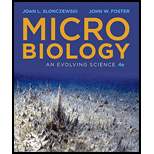
Concept explainers
To review:
The nutrients used by microbes for growth.
Introduction:
The microbial cells are less complex in comparison to the cells of multicellular organisms such as humans but are most abundantly found on the planet. These possess a simple structure but the machinery is quite complex. The most vital factor for the growth and multiplication of the microbial cells is the nutrient supply.
Explanation of Solution
Various nutrients required for the growth as well as development of the microbes are divided into two categories, namely macronutrients and micronutrients. The macronutrients are required in larger concentrations and they play a vital role in the basic
The macronutrients include carbon, nitrogen, phosphorus, hydrogen, oxygen, sulfur, cations magnesium, iron, potassium, and calcium. The elements like cobalt, copper, manganese, nickel, and zinc are included under micronutrients. These micronutrients are added to the growth medium on rare occasions as they are already present as a contamination in glassware which are used for culturing the microbes. Certain microbes also need specialized growth factors.
Want to see more full solutions like this?
Chapter 4 Solutions
Microbiology: An Evolving Science (Fourth Edition)
- In a small summary write down:arrow_forwardNot part of a graded assignment, from a past midtermarrow_forwardNoggin mutation: The mouse, one of the phenotypic consequences of Noggin mutationis mispatterning of the spinal cord, in the posterior region of the mouse embryo, suchthat in the hindlimb region the more ventral fates are lost, and the dorsal Pax3 domain isexpanded. (this experiment is not in the lectures).a. Hypothesis for why: What would be your hypothesis for why the ventral fatesare lost and dorsal fates expanded? Include in your answer the words notochord,BMP, SHH and either (or both of) surface ectoderm or lateral plate mesodermarrow_forward
 Comprehensive Medical Assisting: Administrative a...NursingISBN:9781305964792Author:Wilburta Q. Lindh, Carol D. Tamparo, Barbara M. Dahl, Julie Morris, Cindy CorreaPublisher:Cengage Learning
Comprehensive Medical Assisting: Administrative a...NursingISBN:9781305964792Author:Wilburta Q. Lindh, Carol D. Tamparo, Barbara M. Dahl, Julie Morris, Cindy CorreaPublisher:Cengage Learning Biology 2eBiologyISBN:9781947172517Author:Matthew Douglas, Jung Choi, Mary Ann ClarkPublisher:OpenStax
Biology 2eBiologyISBN:9781947172517Author:Matthew Douglas, Jung Choi, Mary Ann ClarkPublisher:OpenStax





